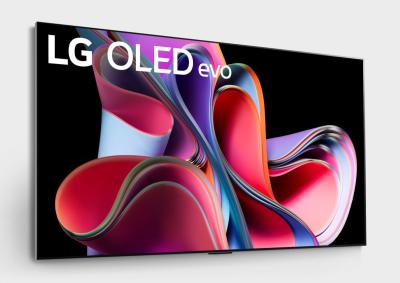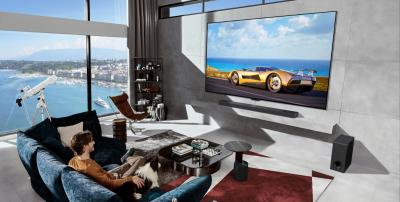 LG Display, based in Korea, is one of the world's largest display makers. LGD produces screens for TVs, laptops and mobile devices, focusing on OLED technologies.
LG Display, based in Korea, is one of the world's largest display makers. LGD produces screens for TVs, laptops and mobile devices, focusing on OLED technologies.
LG Display is the world's leading OLED TV and monitor panel producer (based on its WOLED architecture). The company also produces flexible AMOLEDs for wearables, tablets and smartphones (branded as pOLEDs, and supplied to many companies including Apple). LG Display is also offering automotive OLED displays, transparent OLEDs, and is developing OLED microdisplays.
LG Display supplies WOLED TV panels in a wide range of sizes, from 42-inch to 97-inch, to many companies including Panasonic, LG Electronics, Sony, Philips, Loewe, JVC, Hisense, Konka and others. It is a main AMOLED supplier for Apple's smartwatch, mobile phones and tablet products. It is also considered to be the leading automotive OLED producer.
LG Display has been producing transparent OLEDs since 2019, when the company started commercial production of 55" FHD transparent OLEDs, finding small markets in signage, commercial, mobility and more. The company since expanded its range, although production volume is still limited.
Towards the end of 2015 LG Display acquired LG Chem's OLED lighting business unit for $135 million, but it later withdrew from the lighting market.
128, Yeoui-daero
Yeongdeungpo-gu
Seoul
South Korea
LG Display reported its Q2 2024 financial results, boosted by tablet AMOLED shipments to Apple
LG Display reported its financial results for Q2 2024 - with revenues reaching $4.85 billion (an increase of 42% compared to last year) and a net loss of $67 million (down from around $637 million in 2023).
LG Display benefited greatly from Apple's introduction of its 2024 iPad pro tablets, for which LGD is the main AMOLED supplier. The company is also expecting to sell a record number of iPhone AMOLED panels later this year. LGD says that the proportion of OLED products rose 10% of its total sales, reaching 52% - which means that OLED is now the company's main product line in terms of revenues.
Study reveals OLED TVs promote healthier sleep patterns compared to LCD screens
Seoul's Kookmin University researchers concluded a clinical study to verify the impact of TV panels of sleep, measuring the levels of the sleep-inducing hormone melatonin in 40 adult men and women divided into groups watching the same content on either LCD or LG's WOLED TVs.
The researcher found that melatonin secretion fell 2.7% over two hours for the LCD group and it increased 8.1% in the OLED TV group. Melatonin rises in the evening to prepare the body for sleep, but the blue light emitted from displays disturbs the melatonin secretion as it confuses the body. As LCDs emit about twice as much blue light as OLEDs, it is not a surprise they have this effect on melatonin levels.
LG Display developed new tandem OLED technology to increase brightness and efficiency by 20%
According to a new report by Business Korea, LG Display is finalizing the development of its 3rd-gen tandem-stack automotive OLED technology, and aims to start mass producing these panels by 2026. LGD believes the new panels will improve the brightness and efficiency of its OLEDs by 20% (compared to its current 2nd-gen tandem OLEDs).
LG Display believes it is leading the industry with its tandem OLED technology (and we tend to agree) and it hopes to accelerate its technology development to widen its lead. LG Display is enjoying a lead in the automotive display market with its OLED solutions and has already achieved design wins with many companies, including Genesis, Mercedes-Benz, Cadillac and GM.
Omdia: shipments of OLEDs over 9-inch in size will soar 124% in 2024
According to Omdia, sales of OLED panels in sizes over 9-inch (the company refers to these as Large Area Displays) will increase 124.6% in 2024. In 2023, the market contracted 25.7%, with the only exception being OLED monitor panels that grew in shipments.
In 2024, Omdia says that all application areas will see an increase in shipments - TVs, monitors, tablets and laptops. Only the company's "other" category will see a decrease in sales. In particular, tablet OLED shipments are projected to increase by 294% compared to 2023, largely due to Apple's adoption of OLEDs in the 2024 iPad Pro tablets. Laptop OLED sales will increase 152.6%, and monitors OLEDs will increase 139.9%. Finally, OLED TV panel shipments will increase 34.8%.
Is LG Display leading over Samsung Display with the quality and performance of its latest OLED?
Since Samsung started mass producing AMOLED displays in 2007, most people believe that the company is not only the leader in OLED production capacity, but also in the performance of its displays. In most cases, Samsung has been the first company to develop and manage to mass produce the most advanced OLED displays, and the first to adopt the latest OLED materials, architectures, and processes.
There are some signs that this could be changing, although honestly it's a bit too early to know. In May 2024, Apple launched its first OLED Tablets, and according to reports, Apple chose LG Display as its main supplier, ordering around 60% of its iPad OLEDs from LGD (with all of the 13" model orders going to LG), and the rest from Samsung. Later it was reported that Apple had to delay the introduction of its 2024 iPad Pro devices as Samsung faced low production yields and could not deliver displays in time.
Apple reportedly reaches out to Samsung and LG regarding the supply of OLED microdisplays
According to a report from Korea, Apple has sent an RFI for both Samsung Display and LG Display, seeking more information about the two companies capabilities regarding the production of OLED microdisplays. It is speculated that Apple is seeking to change its OLED supplier in a future, lower-cost VR headset.
Apple specifically mentions a white OLED with color filters architectures (i.e. not a direct-patterned device), a panel size of 2 to 2.1 inch and a display density of around 1,700 PPI (which is rather low, Sony's 4K microdisplays used in the Apple Vision Pro for example offer a density of almost 3,400 PPI).
LG Display starts mass producing 13-inch tandem laptop OLED panels
LG Display says that it has started to mass produce tandem OLED laptop panels, the first company to do so. LGD says its tandem architecture double the lifetime of its OLEDs, reduce power consumption by up to 40%, and enable up to three times the brightness.
LGD has been producing tandem OLED displays since 2019, mainly for the automotive industry. This expertise has enabled it to be Apple's main tandem OLED display suppler for its 2024 iPad Pro devices, and now to be the first one to produce tandem laptop panels.
LG Display gets approved to supply AMOLEDs for the iPhone 16 Pro Max before Samsung Display
Reports from Korea suggest that Apple approved LG Display as a supplier for its upcoming iPhone 16 Pro Max, the most advanced iPhone model to be released this year. Interestingly, LGD apparently got the approval before Samsung Display, Apple's main OLED supplier.
If true, this is the first time that Apple approves LGD first. This does not necessarily mean anything, but it does mean that the technology gap between Samsung and LGD is low, if present at all. Samsung has much higher production capacity compared to LGD, note. The two companies will likely produce panels for all four iPhone 16 models, and it is reported that BOE will supply some panels for the two standard iPhone 16 models.
Omdia: adoption of OLEDs in smartwatch applications grows to 37% of the market
Omdia says that it expects the global smartwatch display market to reach 359 million units in 2024 (up from 259 million units in 2022). OLEDs hold a 37% market share (132 million units).
Omdia says that the leading smartwatch OLED producers, in the first half of 2024, are LG Display (Apple's main supplier), Everdisplay and Tianma - which together hold a 53% market share. China-based wearable OLED production accounts to 64% of the total market.
LG Display teams up with Boeing and LIG Nex1 to show a next-gen aircraft smart cabin
As OLED technologies are making inroads into the aerospace industry, LG Display has teamed up with Boeing and LIG Nex1 to introduce a new aircraft smart cabin concept, utilizing the company's latest OLED displays.
The three companies started collaborating back in 2020, to realize how OLEDs can benefit aircraft interior design. For this project, LG Display developed aircraft-specific OLED panels, ensuring higher reliability and safety compared to regular OLED panels. The new smart cabin concept includes a 55" OLED panel that is installed at the aircraft entrance, curved OLED at the aircraft's ceiling, 30-inch transparent OLED panels placed in the cabin partitions, and a 27-inch OLED panel in the crew galley.
Pagination
- Page 1
- Next page









